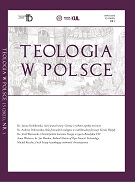Grzech pierworodny tylko analogicznie rozumiany jest jako „grzech”, bo różni sięistotnie od grzechów uczynkowych, które popełnia każdy człowiek. Stajemy siędotknięci skutkami „grzechu Adama” przez dziedziczenie. Doświadczamy przez to nie tylko złego przykładu Praojca, który był nieposłuszny Panu Bogu, lecz przede wszystkim skutków natury ontologicznej. Doświadczamy ich przez pożądliwość i ograniczenia rozumu i wolnej woli.
S. Kunka, WHO DOES ORIGINAL SIN BELONG TO?
Summary
The experience of the mistakes made, false cognition, and weak will uncovers the mystery of human sinfulness. Its underlying reason is the reality described by theology as “original sin.” The Church Tradition considered this theological category starting from the description of the creation and fall of the first parents. The Council of Trent in its decree “Of Original Sin” presents this study of the Church in 6 canons. Original sin is understood as a sin only by analogy, since it differs significantly from personal sins, which each human commits. We are touched by the consequences of “Adam’s sin” by inheritance. By this, we experience not only the bad example of the Pre-father, who was disobedient to God, but, above all, ontological consequences. We experience them through lust and limitations of our mind and free will. Original sin did not, however, destroy human nature. Everyone is, thus, responsible for their decisions and actions. The grace of baptism washes away original sin, but its consequences remain. The proper understanding of the Church’s interpretation of original sin requires presenting this concept in the light of God’s love, revealed in the gift of creation and the gift of redemption to the human. Inasmuch as accepting the existence of sin is based on the Revelation, its proper understanding refers to the Person and acts of Jesus Christ – the “New Adam.”
Ostatnia aktualizacja: 26.03.2012, godz. 00:11 - Natalia Haniewska































